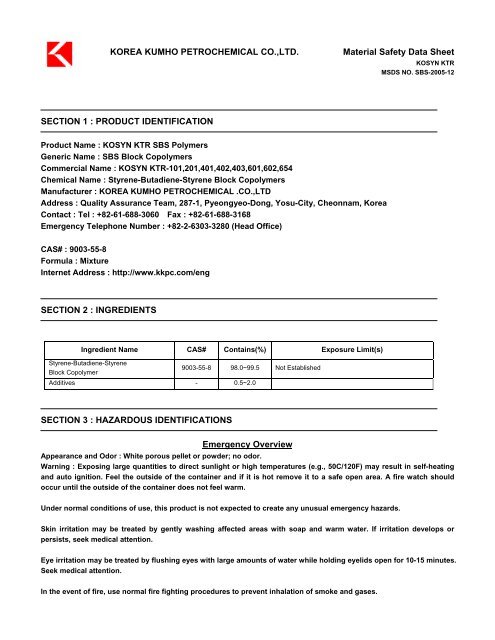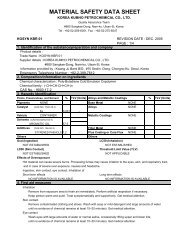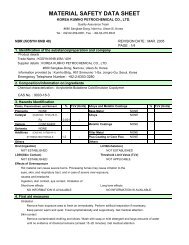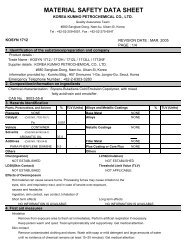kumho ktr sbs - tcirubber
kumho ktr sbs - tcirubber
kumho ktr sbs - tcirubber
Create successful ePaper yourself
Turn your PDF publications into a flip-book with our unique Google optimized e-Paper software.
KOREA KUMHO PETROCHEMICAL CO.,LTD. Material Safety Data Sheet<br />
SECTION 1 : PRODUCT IDENTIFICATION<br />
Product Name : KOSYN KTR SBS Polymers<br />
Generic Name : SBS Block Copolymers<br />
Commercial Name : KOSYN KTR-101,201,401,402,403,601,602,654<br />
Chemical Name : Styrene-Butadiene-Styrene Block Copolymers<br />
Manufacturer : KOREA KUMHO PETROCHEMICAL .CO.,LTD<br />
Address : Quality Assurance Team, 287-1, Pyeongyeo-Dong, Yosu-City, Cheonnam, Korea<br />
Contact : Tel : +82-61-688-3060 Fax : +82-61-688-3168<br />
Emergency Telephone Number : +82-2-6303-3280 (Head Office)<br />
CAS# : 9003-55-8<br />
Formula : Mixture<br />
Internet Address : http://www.kkpc.com/eng<br />
SECTION 2 : INGREDIENTS<br />
Ingredient Name CAS# Contains(%) Exposure Limit(s)<br />
Styrene-Butadiene-Styrene<br />
Block Copolymer<br />
9003-55-8 98.0~99.5 Not Established<br />
Additives - 0.5~2.0<br />
SECTION 3 : HAZARDOUS IDENTIFICATIONS<br />
KOSYN KTR<br />
MSDS NO. SBS-2005-12<br />
Emergency Overview<br />
Appearance and Odor : White porous pellet or powder; no odor.<br />
Warning : Exposing large quantities to direct sunlight or high temperatures (e.g., 50C/120F) may result in self-heating<br />
and auto ignition. Feel the outside of the container and if it is hot remove it to a safe open area. A fire watch should<br />
occur until the outside of the container does not feel warm.<br />
Under normal conditions of use, this product is not expected to create any unusual emergency hazards.<br />
Skin irritation may be treated by gently washing affected areas with soap and warm water. If irritation develops or<br />
persists, seek medical attention.<br />
Eye irritation may be treated by flushing eyes with large amounts of water while holding eyelids open for 10-15 minutes.<br />
Seek medical attention.<br />
In the event of fire, use normal fire fighting procedures to prevent inhalation of smoke and gases.
Potential Health Effects<br />
Summary:<br />
Exposure to dust from this product may be irritating to the eyes, respiratory passages, and mucous membranes.<br />
Acute (Short-Term) Health Effects:<br />
Dust from this product is a mechanical irritant, which means that it may cause irritation or scratchiness of the throat and/or<br />
itching of the eyes and skin.<br />
Chronic (Long-Term) Health Effects:<br />
Long-term inhalation of asbestos-free dust may cause non-cancerous pulmonary fibrosis.<br />
Target Organs:<br />
Respiratory system, skin, and eyes.<br />
Primary Routes of Entry (Exposure):<br />
Inhalation, skin, and eye contact.<br />
Medical Conditions Which May Be Aggravated:<br />
Pre-existing respiratory, skin or eye diseases or conditions.<br />
Symptoms Of Overexposure<br />
Inhalation:<br />
Irritation of the upper respiratory tract (scratchy throat), coughing, and congestion may occur in extreme exposures.<br />
Skin:<br />
Temporary irritation (itching) or redness may occur.<br />
Absorption:<br />
Not applicable.<br />
Ingestion:<br />
This product is not intended to be ingested or eaten under normal conditions of use. If ingested, it may cause temporary irritation<br />
to the gastrointestinal (GI) tract, especially the stomach.<br />
Eye:<br />
Temporary irritation (itching) or redness may occur.<br />
SECTION 4 : FIRST AID MEASURES<br />
Inhalation:<br />
Remove to fresh air. Drink water to clear throat, and blow nose to remove dust and fibers.<br />
Skin:<br />
Wash gently with soap and warm water to remove dust and fibers. Wash hands before eating or using the restroom.<br />
Absorption:<br />
Not applicable.<br />
Ingestion:<br />
Product is not intended to be ingested or eaten. If this product is ingested, irritation of the GI (gastrointestinal) tract may occur,<br />
and should be treated symptomatically. Rinse mouth with water to remove dust, and drink plenty of water to help reduce the<br />
irritation.<br />
Eye:<br />
Do not rub or scratch eyes. Dust particles may cause the eye to be scratched. Flush eyes with large amounts of water for 5-15<br />
minutes. If irritation persists, contact a physician.<br />
Notes to Physician:<br />
This product is not expected to produce any chronic health effects from acute exposures. Treatment should be directed toward<br />
removing the source of irritation with symptomatic treatment as necessary.
SECTION 5 : FIRE FIGHTING MEASURES<br />
Summary:<br />
Normal fire fighting procedures should be followed to avoid inhalation of smoke and gases.<br />
Unusual Fire/Explosion Hazards:<br />
WARNING: Accumulation of product in areas exposed to elevated temperatures (e.g., 50C/120F, direct sunlight, etc.) for<br />
extended periods of time may result in self-heating and auto ignition. Feel the outside of the container and if it is warm remove it<br />
to a safe open area. A fire watch should occur until the outside of the container does not feel warm.<br />
Extinguishing Media:<br />
Carbon dioxide (CO2), dry chemical, or foam.<br />
Flammable Properties and Explosive Limits:<br />
Flash Point: Not determined<br />
FP Test Method: Not determined<br />
Flame Classification: Not determined<br />
Flame Propagation: Not determined<br />
Lower Explosive Limit (LEL): Not determined<br />
Upper Explosive Limit (UEL): Not determined<br />
Auto ignition Temperature: Not determined<br />
Decomposition Temperature: Not determined<br />
SECTION 6 : ACCIDENTAL SPILL/RELEASE MEASURES<br />
Containment Procedures:<br />
Vacuum dusts. If sweeping is necessary, use a dust suppressant such as water. Do not dry sweep dust or use compressed air<br />
for clean-up. These procedures will help to minimize potential exposures.<br />
Disposal:<br />
Wastes are not hazardous as defined by the Resource Conservation and Recovery Act (RCRA; 40 CFR 261). Comply with state<br />
and local regulations for disposal of this product. If you are unsure of the regulations, contact your local Public Health<br />
Department, or the local office of the Environmental Protection Agency (EPA).<br />
SECTION 7 : HANDLING AND STORAGE<br />
Storage Handling:<br />
Use protective equipment as described in Section 8 of this material safety data sheet when handling uncontained material.<br />
Warehouse storage should be in accordance with package directions, if any. Materials should be kept dry, and protected from<br />
the elements.<br />
Conditions to Avoid:<br />
Do not store material where it may be exposed to elevated temperatures (e.g., 50°C/120°F, direct sunlight, etc.) for extended<br />
periods of time. Store away from sources of ignition, flame and heat .<br />
SECTION 8 : EXPOSURE CONTROL/PERSONAL PROTECTION<br />
Summary:<br />
Protective equipment should be provided as necessary to prevent irritation to the respiratory tract, eyes, and skin, and to keep<br />
exposure levels below the applicable exposure limits identified in Section 2.<br />
Eye:<br />
Safety glasses or goggles with side shields are recommended to keep dust and fibers out of the eyes.
Skin:<br />
Leather or cotton gloves should be worn to prevent skin contact and irritation. Barrier creams may also be used to reduce skin<br />
contact and irritation.<br />
Respiratory:<br />
A respirator should be used if ventilation is unavailable, or is inadequate for keeping dust and fiber levels below the applicable<br />
exposure limits. In those cases, use a NIOSH-certified disposable or reusable particulate respirator with an efficiency rating of<br />
N95 or higher (under 42 CFR 84) when working with this product. For exposures up to five times the established exposure limits<br />
use a quarter-mask respirator, rated N95 or higher; and for exposures up to ten times the established exposure limits use a<br />
half-mask respirator (e.g., MSA's DM-11, Racal's Delta N95, 3M's 8210), rated N95 or higher. For exposures up to 50 times the<br />
established exposure limits use a full-face respirator, rated N99 or higher.<br />
Ventilation:<br />
The need for ventilation systems should be evaluated by a professional industrial hygienist, while the design of specific<br />
ventilation systems should be conducted by a professional engineer.<br />
Other:<br />
Loose-fitting, long-sleeved clothing should be worn to protect skin from exposure. Exposed areas should be washed with soap<br />
and warm water. Clothing should be washed separately from other clothes, and the washer should be rinsed thoroughly (run<br />
empty for a complete wash cycle).<br />
Special Considerations for Repair/Maintenance of Contaminated Equipment:<br />
For repair/maintenance of contaminated equipment, follow procedures outlined above to protect from exposure to this material<br />
where applicable.<br />
SECTION 9 : PHYSICAL AND CHEMICAL PROPERTIES<br />
Boiling Point (℉/℃): Not determined<br />
Evaporation Rate (Butyl acetate = 1) : Not determined<br />
Melting Point: Not determined<br />
pH: Not determined<br />
Saturation in Air (%): Not applicable<br />
Solids Content: Not determined<br />
Specific Gravity (Water = 1): 0.94<br />
Vapor Density (Air = 1): Not determined<br />
Vapor Pressure: Not determined<br />
Viscosity: Not determined<br />
VOCs (g/liter): Not determined<br />
Volatile by Volume (%): Not determined<br />
Water Solubility (%): Not determined<br />
Percent Volatile by Mass (%) < 1.5<br />
Appearance and Odor: White porous pellet or powder; no odor.<br />
SECTION 10 : STABILITY AND REACTIVITY<br />
Product is stable. Hazardous polymerization will not occur.<br />
Reactivity:<br />
This product is not reactive.<br />
Hazardous Decomposition Products:<br />
The decomposition products from this material are those that would be expected from any organic (carbon-containing) material,<br />
and are mainly derived from pyrolysis, or burning, of the polymer. These decomposition products may include carbon dioxide,<br />
carbon monoxide, carbon particles, and traces of hydrogen cyanide.
SECTION 11 : TOXICOLOGICAL AND EPIDEMIOLOGICAL DATA<br />
This product has not been tested as a separate entity. Therefore, the hazards must be evaluated on the basis of the individual<br />
ingredients, and those hazards must be assumed to be additive in the absence of complete information. The hazards described<br />
in this document have been evaluated on a threshold of 1.0% for all hazardous ingredients and 0.1% for all carcinogens.<br />
Acute Effects:<br />
The fibers and dust from this product are mechanical irritants and may cause transitory irritation to exposed areas such as eyes,<br />
skin and upper respiratory tract.<br />
Toxicity (LD50):<br />
Product toxicity has not been determined.<br />
Chronic Effects:<br />
Fibrous industrial dust causes pneumoconiosis often accompanied by chronic hypertrophic pulmonary osteoarthropathy in<br />
humans exposed for long periods of time. In experimental mammals, pure dust induces a cytogenic rather than fibrogenic effect<br />
on the lungs. Although some fibrogenic agents such as quartz and tremolite may have an additive effect on lung damage, some<br />
evidence has been found to suggest that pure dust inhibits the pathogenicity of quartz.<br />
References:<br />
Proctor, N.H., et al., "Chemical Hazards of the Workplace," 2nd Edition, Philadelphia, PA, J.B. Lippincott Company, 1988.<br />
"Handbook of Toxic and Hazardous Chemicals and Carcinogens," 2nd Edition, Sittig, M., Editor, Noyes Publications, Park Ridge,<br />
NJ, 1985.<br />
SECTION 12 : ECOLOGICAL INFORMATION<br />
Ecotoxicity:<br />
This product has not been tested.<br />
SECTION 13 : DISPOSAL CONSIDERATIONS<br />
Summary:<br />
This product is not regulated as a hazardous waste by the U.S. Environmental Protection Agency (EPA) under Resource<br />
Conservation and Recovery Act (RCRA) regulations. If you are unsure of the regulations, contact your local Public Health<br />
Department, or the local office of the EPA.<br />
SECTION 14 : TRANSPORT INFORMATION<br />
Transportation Summary:<br />
This product is not regulated as a hazardous material for transport.<br />
SECTION 15 : REGULATORY INFORMATION<br />
U. S. REGULATIONS<br />
Federal Regulations:<br />
The Occupational Safety and Health Administration (OSHA), National Toxicology Program (NTP), International Agency for<br />
Research on Cancer (IARC), and American Conference of Governmental Industrial Hygienists (ACGIH) have not classified this<br />
product as a carcinogen.<br />
The Permissible Exposure Limits (PELs) reported in this MSDS are from the air contaminants standard OSHA issued in 1989.
While an appeals court eventually vacated this standard, it was without authority to reverse state law under which states,<br />
operating with their own OSHA programs, had adopted the 1989 standard. Below is a list of states enforcing the 1989 standard.<br />
Please also refer to 29 CFR 1910.1000 and to relevant state statutes for other applicable exposure limits.<br />
Environmental Regulations:<br />
There are no components in this product regulated by the Environmental Protection Agency (EPA) under the Superfund<br />
Amendments and Reauthorization Act (SARA Title III); the Comprehensive Environmental Response, Compensation, and<br />
Liability Act (CERCLA), or the Toxic Substance Control Act (TSCA).<br />
Toxic Substances Control Act Inventory (TSCA 8(b)): This product and its components are listed.<br />
INTERNATIONAL REGULATIONS<br />
Canada Environmental Protection Act Domestic Substance List (Section 25(1) DSL):<br />
This product and its components are listed.<br />
--- END OF MSDS SBS2005-12 ---





